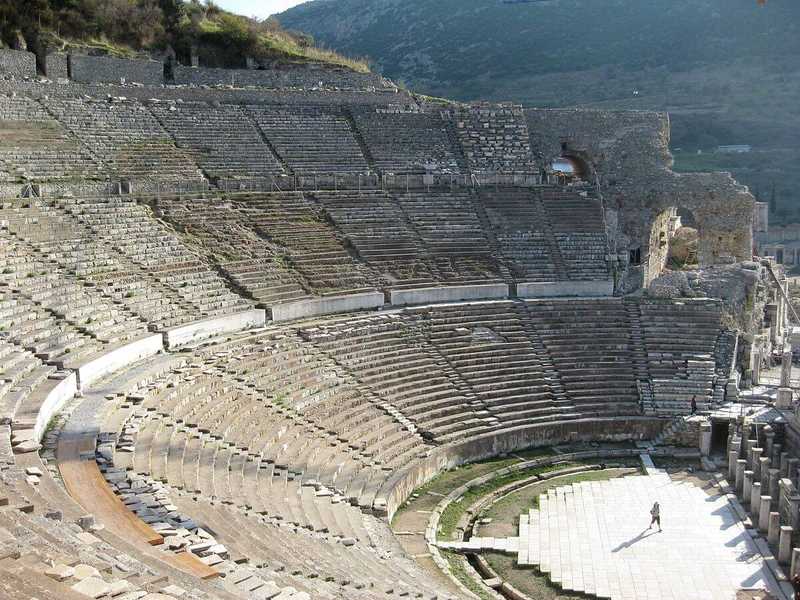The Great Theatre of Ephesus is set into the western slope of Mt Panayır overlooking the harbour at the inland end of the Arcadiane.
Its construction began originally in the Hellenistic Period, drawing on the features of the surrounding landscape; enlargements and additions were made during the reign of Emperor Claudius (42-54 AD) and the building was finally completed under the Emperor Trajan (98 - 117 AD). A later extension westwards produced a stage 150 metres in diameter, and in its final incarnation the theatre was a vast, magnificent edifice seating an audience of 25,000. Although little of the superb ornamentation survives today, it was one of the greatest theatres of the ancient World.
As well as hosting cultural events and gladiator games, the theatre also served as a meeting place for he political assembly of citizens (Ecclesia). The upper galleries of the auditorium stood 60 metres above the level of the stage, while the front of the stage and orchestra were decorated with niches, columns, reliefs and sculptures. The skene (stage building) comprised three storeys, the first two being built during the reign of Emperor Nero (54-68 AD) and the third added under Septimus Severus (193-211 AD). In the front section of the theatre there is a fountain dating from the Hellenistic Period.
The theatre was badly damaged in a series of earthquakes, the first striking in 262 AD with more following in 359-366 AD. From the on, entertainment at the theatre was limited to gladiatorial fights and circus-style spectacles. Come the eight century AD, the theatre lost its real function altogether; taking on a defence role, it became used as a watchtower on account of the city walls passing through the skene. Situated at the hub of the city on the Sacred (Marble) Way, the theatre served as a stopping place on the route of ritual processions to the Temple of Artemis, as well as an important meeting and gathering venue fort he people of Ephesus.
During the spread of Chtistianity, it was also where silversmiths protested against the missionary zeal of St Paul. This incident is referred to in the New Testament, which mentions the artisan, Demetrius, challenging St Paul in the theatre and so inciting the crowds to cry one voice, “Grate is Artemis of the Ephesians!”
In addition to emperors and city dignitaries, there were also statues of the gods Dionysus, Apollo, Fortuna and Nemesis. The second storey of the skene featured an intricately cared frieze of hunting cupids and reclining satyrs.
In Late Antiquity, the busts of various emperors and governors were also incorporated into the theatre. In the top section of the cavea there is a tier of seats fronted by a colonnade, which must presumably have been a sacred area dedicated to the goddess, Nemesis.
Just outside the skene of the Great Theatre are the remains of a fountain building dating from the Hellenistic Period. The fountain, which originally measured 3.82 x 1.45 metres, can be seen at the top of the Marble Way while visiting the theatre. Some parts of the fountain structure were clad in marble slabs. Water flowed into the fountain from the heads of lions (no longer in situ) which were mounted onto the back walls. A number of columns crowned with Ionic capitals survive today and these bear an inscription, which states that the fountain’s water supply was provided by the Marnas River.

